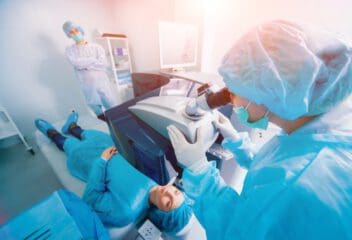What Is the Recovery Time After Ptosis Surgery?
Home / Eye Conditions & Eye Diseases / Guide to Ptosis /
Last Updated:
It can take up to three months to fully recover from ptosis surgery.
The recovery happens in stages. Understanding these stages ensures that people are informed about what happens after their doctor completes the procedure.
Ptosis is a condition characterized by the eyelid drooping over the eye. For some people, the drooping is barely noticeable. However, for other people, the drooping can obstruct their vision.
Table of Contents
There are two primary ptosis surgery techniques doctors use. The type of ptosis a person has and the degree of drooping play a role in deciding which technique is the best option.
The general technique involves tightening the levator muscle. The sling technique involves using the frontalis muscle to lift the eyelid.
In some cases, once a person heals, they will not be happy with their results. In these cases, they can discuss revision surgery with their doctor to see if it might improve the look of their eye.
Timeline for Recovery

It can take up to three months for someone to fully recover from ptosis surgery. This is the timeline for both of the primary surgical techniques.
The following describes what you can expect during recovery:
- For the first three days, patients should ice the area according to the doctor’s instructions.
- Four to six times daily until the sutures are removed, the area should be cleaned per the doctor’s instructions.
- About a week after surgery, the sutures are typically removed.
- It is generally recommended that people take up to 10 days off work to rest.
- Exercise can usually resume in approximately three weeks.
- At the two-month mark, minimal swelling is still possible.
- At the three-month mark, the person should be fully healed.
Ptosis Surgery Recovery Time
Your doctor will want to see you every month following surgery to gauge your recovery and examine the movement of your eyelid to see how it is healing.
Immediately after surgery, your eyelid might feel tight and sore. Your eye may also be watery, dry, itchy or ultra-sensitive to light. You could also experience blurry vision for a few days after the procedure. Your doctor may prescribe a thick ointment to help keep your eye moist and well-lubricated.
Some bruising is normal up to two weeks after ptosis surgery, and you might experience swelling for several weeks.
You might notice some changes in the position of your eyelid as the healing process progresses. The eyelid might not achieve its final position until two or three months after surgery.
Types of Ptosis Surgery
There is a general technique and a sling technique a doctor may perform. Both of these differ, so it is important to understand their differences.
Possible Complications
All surgeries come with the risk of complications. Choose a qualified doctor and follow all preparation and aftercare instructions to minimize risks.
You deserve clear vision. We can help.
With 135+ locations and over 2.5 million procedures performed, our board-certified eye surgeons deliver results you can trust.
Your journey to better vision starts here.
While rare, there is the risk of loss of eyelid movement. This could make it impossible for someone to close and open their eyelid naturally.
Poor lid crease is another potential issue. However, making a single incision can help to correct it so the lid crease is where it should be.
Overcorrection is another potential complication. It is not common, and when it does occur, it is usually people who had surgery for congenital ptosis. To correct this issue, the surgeon has to cut the offending suture that caused it and take the wound down. When this complication is very slight, two to three months of massage may resolve it.
There is the possibility of the eyelids not looking symmetrical after the surgery. Once the person has fully recovered, there are revision surgery options that may help to correct the issue if this problem is still present.
Revision Surgery

During recovery, it is important to be patient because the eyelid position will change due to the swelling that is normal after surgery. It may be three months before the final position of the eyelid is realized.
After three months, the doctor will evaluate the eyelid and determine if the person is happy with their results. If not, there is the possibility that revision surgery is possible to improve the results.
In many cases, revision surgery consists of a few small adjustments. The surgery is typically not extensive. For some people, the ptosis surgery technique used for the first procedure can be repeated to enhance the results.
Tips to Promote Recovery
When a person has any eye surgery, there are certain things to avoid and some things to do that will promote recovery. Follow these tips and any other advice provided by your doctor:
- Follow all post-surgical instructions provided by the doctor.
- Use ice packs as recommended.
- Avoid heavy lifting, straining, and swimming for the recommended time period.
- Avoid smoking.
- Do not wear contact lenses until the doctor says it is okay.
- Keep your head raised while sleeping for a few days.
- Avoid blood-thinning medications for approximately one week.
- Clean the surgical site per the doctor’s instructions using only approved cleansers.
- Do not smoke.
- Do not rub the eyes.
- Wear sunglasses to protect the eye area.
You deserve clear vision. We can help.
With 135+ locations and over 2.5 million procedures performed, our board-certified eye surgeons deliver results you can trust.
Your journey to better vision starts here.
General Technique

With the general technique, there are two approaches the surgeon may use, including an external approach and an internal approach.
The external approach is also referred to as levator advancement. When the person has a high upper eyelid crease and normal levator function, this is the most commonly used technique.
The procedure happens as follows:
- The surgeon cuts into the eyelid skin.
- They take the levator muscle attachment and reposition it so it is attached to the tarsus.
- Sutures are used to keep the new position of the levator muscle.
This helps to raise the eyelid, so the drooping is not as apparent. People are not put to sleep for this procedure, but they do get sedation to ensure comfort.
The internal approach is another technique the doctor might consider when a person has strong levator function. With this technique, the eyelid is turned inside out. The surgeon then shortens the eyelid muscles. This may include shortening either the Mueller’s muscle or the levator muscle, depending on which one is contributing to the drooping.

The surgeon usually focuses on the levator muscle when the person needs more of a lift for their eyelid. The Mueller’s muscle is targeted when only a subtle lift of the eyelid is necessary. For this procedure, the doctor will administer either sedation or general anesthesia.
Sling Technique
Frontalis suspension is a surgical technique used to rectify drooping of the upper eyelid owing to poor, sometimes absent, function of the levator muscle.
The procedure is used to enhance the connection between the frontalis muscle and the upper eyelid enabling the frontalis muscle to elevate the eyelid. The point of connection is just above the eyebrows.
Surgeons use a sling-type material, usually autogenous fascia lata, to connect the upper eyelid to the brow. They can also use synthetic sutures, graft materials, preserved donor sclera and muscle tendons.
The technique requires cutaneous incisions to be made at the eyebrow and tarsus level (plate of connective tissue on the upper eyelid). The sling material is then passed through the incision to allow the frontalis muscle to control the eyelid.
For underage individuals with congenital ptosis, the child’s face must be allowed to grow and mature before surgical intervention. Typically, children get frontalis suspension surgery between 3 to 5 years old.
You deserve clear vision. We can help.
With 135+ locations and over 2.5 million procedures performed, our board-certified eye surgeons deliver results you can trust.
Your journey to better vision starts here.
References
- What Is Ptosis? American Academy of Ophthalmology.
- Recovery and Support for Ptosis. NYU Langone Health.
- Blepharoplasty. Mayo Clinic.
- Ptosis (Drooping Eyelid). All About Vision.
- Complications of Ptosis Surgery. Journal of Pediatric Ophthalmology and Strabismus.
- Ptosis Blepharoplasty Treatment and Management. Medscape.
- Frontalis Suspension Procedure. (January 17, 2021). American Academy of Ophthalmology.
This content is for informational purposes only. It may have been reviewed by a licensed physician, but is not intended to serve as a substitute for professional medical advice. Always consult your healthcare provider with any health concerns. For more, read our Privacy Policy and Editorial Policy.
